GSBS6004 Organisational Behaviour and Design Essay 2022
VerifiedAdded on 2022/03/05
|7
|2121
|16
Essay
AI Summary
Contribute Materials
Your contribution can guide someone’s learning journey. Share your
documents today.
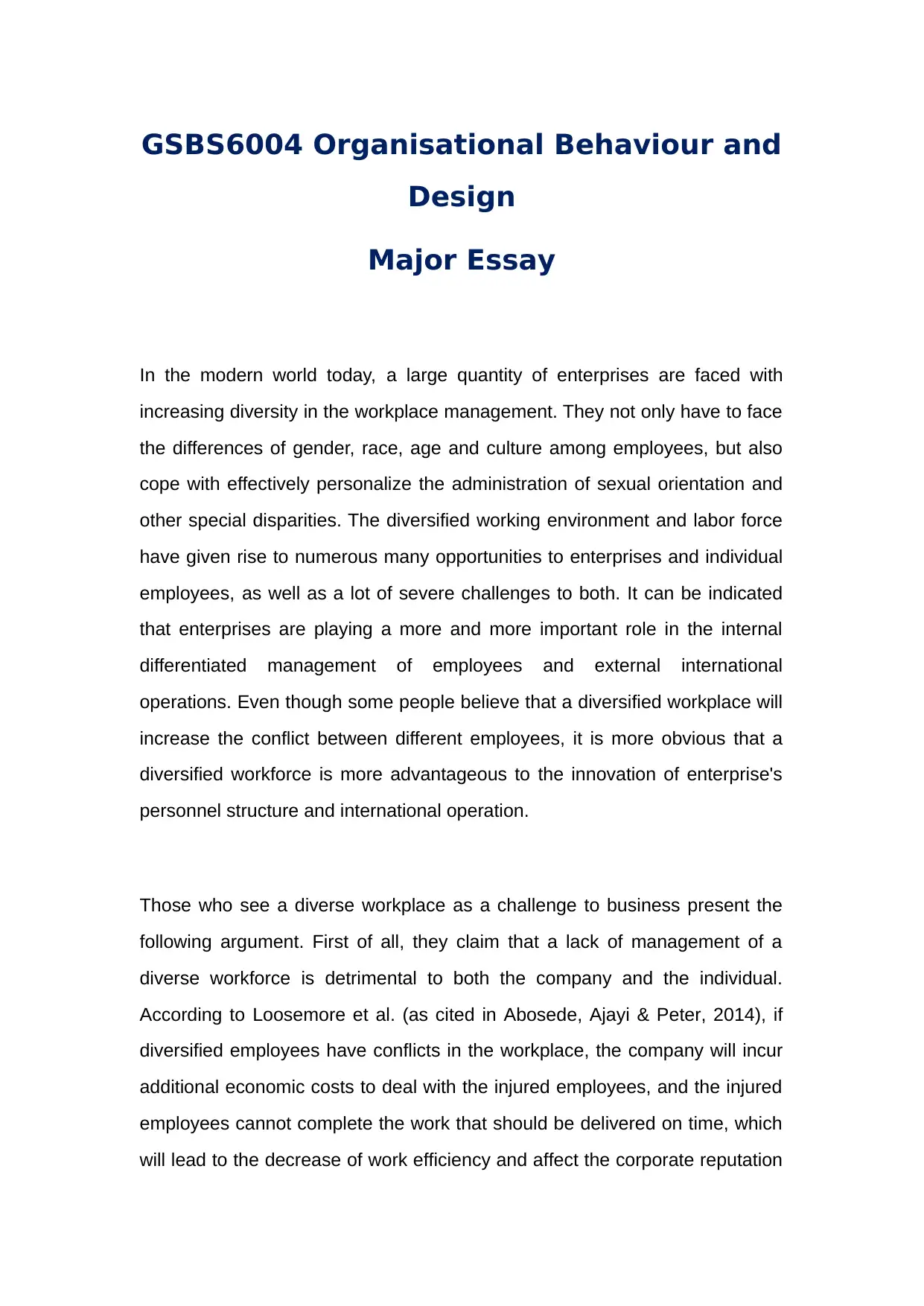
GSBS6004 Organisational Behaviour and
Design
Major Essay
In the modern world today, a large quantity of enterprises are faced with
increasing diversity in the workplace management. They not only have to face
the differences of gender, race, age and culture among employees, but also
cope with effectively personalize the administration of sexual orientation and
other special disparities. The diversified working environment and labor force
have given rise to numerous many opportunities to enterprises and individual
employees, as well as a lot of severe challenges to both. It can be indicated
that enterprises are playing a more and more important role in the internal
differentiated management of employees and external international
operations. Even though some people believe that a diversified workplace will
increase the conflict between different employees, it is more obvious that a
diversified workforce is more advantageous to the innovation of enterprise's
personnel structure and international operation.
Those who see a diverse workplace as a challenge to business present the
following argument. First of all, they claim that a lack of management of a
diverse workforce is detrimental to both the company and the individual.
According to Loosemore et al. (as cited in Abosede, Ajayi & Peter, 2014), if
diversified employees have conflicts in the workplace, the company will incur
additional economic costs to deal with the injured employees, and the injured
employees cannot complete the work that should be delivered on time, which
will lead to the decrease of work efficiency and affect the corporate reputation
Design
Major Essay
In the modern world today, a large quantity of enterprises are faced with
increasing diversity in the workplace management. They not only have to face
the differences of gender, race, age and culture among employees, but also
cope with effectively personalize the administration of sexual orientation and
other special disparities. The diversified working environment and labor force
have given rise to numerous many opportunities to enterprises and individual
employees, as well as a lot of severe challenges to both. It can be indicated
that enterprises are playing a more and more important role in the internal
differentiated management of employees and external international
operations. Even though some people believe that a diversified workplace will
increase the conflict between different employees, it is more obvious that a
diversified workforce is more advantageous to the innovation of enterprise's
personnel structure and international operation.
Those who see a diverse workplace as a challenge to business present the
following argument. First of all, they claim that a lack of management of a
diverse workforce is detrimental to both the company and the individual.
According to Loosemore et al. (as cited in Abosede, Ajayi & Peter, 2014), if
diversified employees have conflicts in the workplace, the company will incur
additional economic costs to deal with the injured employees, and the injured
employees cannot complete the work that should be delivered on time, which
will lead to the decrease of work efficiency and affect the corporate reputation
Secure Best Marks with AI Grader
Need help grading? Try our AI Grader for instant feedback on your assignments.
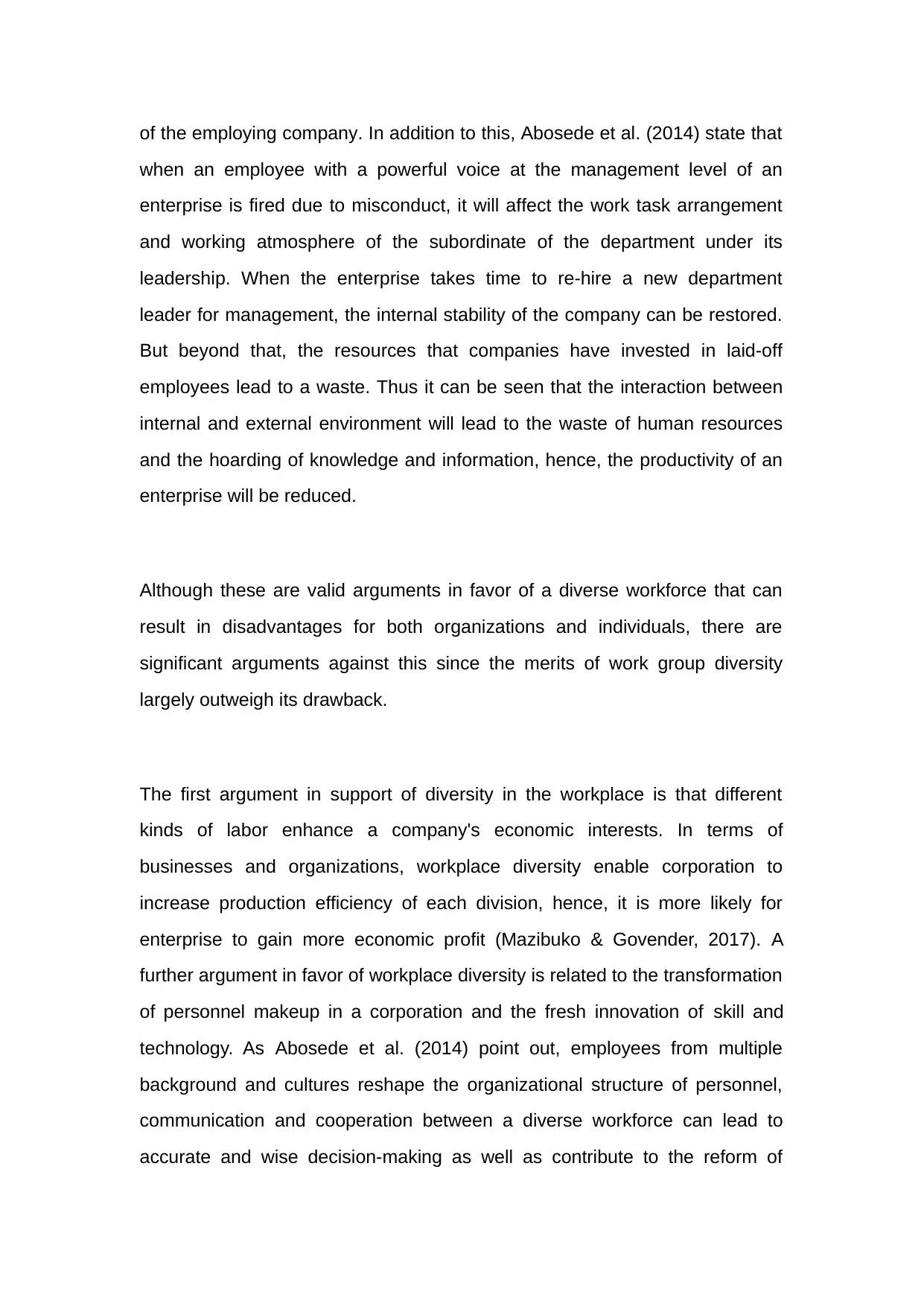
of the employing company. In addition to this, Abosede et al. (2014) state that
when an employee with a powerful voice at the management level of an
enterprise is fired due to misconduct, it will affect the work task arrangement
and working atmosphere of the subordinate of the department under its
leadership. When the enterprise takes time to re-hire a new department
leader for management, the internal stability of the company can be restored.
But beyond that, the resources that companies have invested in laid-off
employees lead to a waste. Thus it can be seen that the interaction between
internal and external environment will lead to the waste of human resources
and the hoarding of knowledge and information, hence, the productivity of an
enterprise will be reduced.
Although these are valid arguments in favor of a diverse workforce that can
result in disadvantages for both organizations and individuals, there are
significant arguments against this since the merits of work group diversity
largely outweigh its drawback.
The first argument in support of diversity in the workplace is that different
kinds of labor enhance a company's economic interests. In terms of
businesses and organizations, workplace diversity enable corporation to
increase production efficiency of each division, hence, it is more likely for
enterprise to gain more economic profit (Mazibuko & Govender, 2017). A
further argument in favor of workplace diversity is related to the transformation
of personnel makeup in a corporation and the fresh innovation of skill and
technology. As Abosede et al. (2014) point out, employees from multiple
background and cultures reshape the organizational structure of personnel,
communication and cooperation between a diverse workforce can lead to
accurate and wise decision-making as well as contribute to the reform of
when an employee with a powerful voice at the management level of an
enterprise is fired due to misconduct, it will affect the work task arrangement
and working atmosphere of the subordinate of the department under its
leadership. When the enterprise takes time to re-hire a new department
leader for management, the internal stability of the company can be restored.
But beyond that, the resources that companies have invested in laid-off
employees lead to a waste. Thus it can be seen that the interaction between
internal and external environment will lead to the waste of human resources
and the hoarding of knowledge and information, hence, the productivity of an
enterprise will be reduced.
Although these are valid arguments in favor of a diverse workforce that can
result in disadvantages for both organizations and individuals, there are
significant arguments against this since the merits of work group diversity
largely outweigh its drawback.
The first argument in support of diversity in the workplace is that different
kinds of labor enhance a company's economic interests. In terms of
businesses and organizations, workplace diversity enable corporation to
increase production efficiency of each division, hence, it is more likely for
enterprise to gain more economic profit (Mazibuko & Govender, 2017). A
further argument in favor of workplace diversity is related to the transformation
of personnel makeup in a corporation and the fresh innovation of skill and
technology. As Abosede et al. (2014) point out, employees from multiple
background and cultures reshape the organizational structure of personnel,
communication and cooperation between a diverse workforce can lead to
accurate and wise decision-making as well as contribute to the reform of
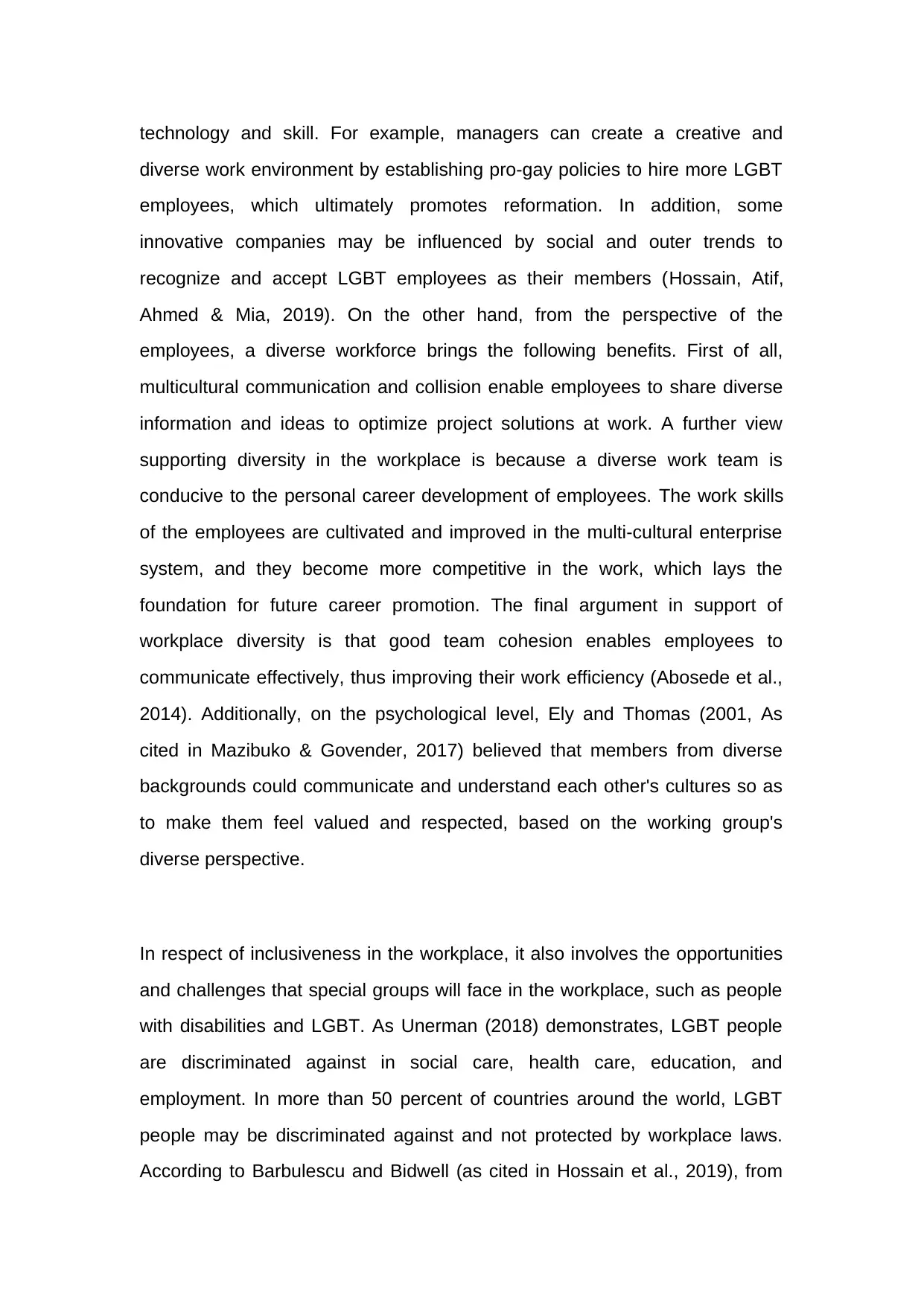
technology and skill. For example, managers can create a creative and
diverse work environment by establishing pro-gay policies to hire more LGBT
employees, which ultimately promotes reformation. In addition, some
innovative companies may be influenced by social and outer trends to
recognize and accept LGBT employees as their members (Hossain, Atif,
Ahmed & Mia, 2019). On the other hand, from the perspective of the
employees, a diverse workforce brings the following benefits. First of all,
multicultural communication and collision enable employees to share diverse
information and ideas to optimize project solutions at work. A further view
supporting diversity in the workplace is because a diverse work team is
conducive to the personal career development of employees. The work skills
of the employees are cultivated and improved in the multi-cultural enterprise
system, and they become more competitive in the work, which lays the
foundation for future career promotion. The final argument in support of
workplace diversity is that good team cohesion enables employees to
communicate effectively, thus improving their work efficiency (Abosede et al.,
2014). Additionally, on the psychological level, Ely and Thomas (2001, As
cited in Mazibuko & Govender, 2017) believed that members from diverse
backgrounds could communicate and understand each other's cultures so as
to make them feel valued and respected, based on the working group's
diverse perspective.
In respect of inclusiveness in the workplace, it also involves the opportunities
and challenges that special groups will face in the workplace, such as people
with disabilities and LGBT. As Unerman (2018) demonstrates, LGBT people
are discriminated against in social care, health care, education, and
employment. In more than 50 percent of countries around the world, LGBT
people may be discriminated against and not protected by workplace laws.
According to Barbulescu and Bidwell (as cited in Hossain et al., 2019), from
diverse work environment by establishing pro-gay policies to hire more LGBT
employees, which ultimately promotes reformation. In addition, some
innovative companies may be influenced by social and outer trends to
recognize and accept LGBT employees as their members (Hossain, Atif,
Ahmed & Mia, 2019). On the other hand, from the perspective of the
employees, a diverse workforce brings the following benefits. First of all,
multicultural communication and collision enable employees to share diverse
information and ideas to optimize project solutions at work. A further view
supporting diversity in the workplace is because a diverse work team is
conducive to the personal career development of employees. The work skills
of the employees are cultivated and improved in the multi-cultural enterprise
system, and they become more competitive in the work, which lays the
foundation for future career promotion. The final argument in support of
workplace diversity is that good team cohesion enables employees to
communicate effectively, thus improving their work efficiency (Abosede et al.,
2014). Additionally, on the psychological level, Ely and Thomas (2001, As
cited in Mazibuko & Govender, 2017) believed that members from diverse
backgrounds could communicate and understand each other's cultures so as
to make them feel valued and respected, based on the working group's
diverse perspective.
In respect of inclusiveness in the workplace, it also involves the opportunities
and challenges that special groups will face in the workplace, such as people
with disabilities and LGBT. As Unerman (2018) demonstrates, LGBT people
are discriminated against in social care, health care, education, and
employment. In more than 50 percent of countries around the world, LGBT
people may be discriminated against and not protected by workplace laws.
According to Barbulescu and Bidwell (as cited in Hossain et al., 2019), from
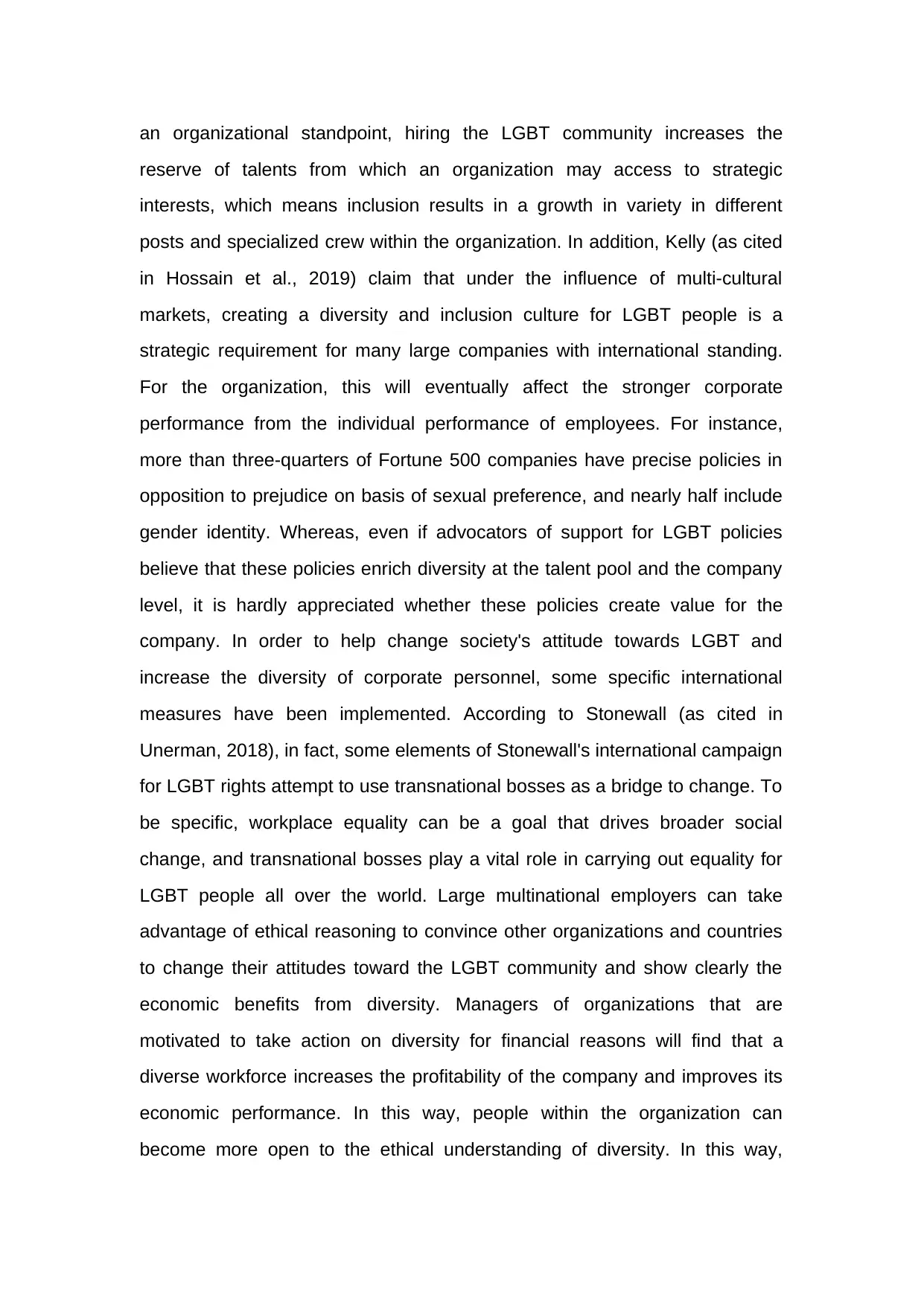
an organizational standpoint, hiring the LGBT community increases the
reserve of talents from which an organization may access to strategic
interests, which means inclusion results in a growth in variety in different
posts and specialized crew within the organization. In addition, Kelly (as cited
in Hossain et al., 2019) claim that under the influence of multi-cultural
markets, creating a diversity and inclusion culture for LGBT people is a
strategic requirement for many large companies with international standing.
For the organization, this will eventually affect the stronger corporate
performance from the individual performance of employees. For instance,
more than three-quarters of Fortune 500 companies have precise policies in
opposition to prejudice on basis of sexual preference, and nearly half include
gender identity. Whereas, even if advocators of support for LGBT policies
believe that these policies enrich diversity at the talent pool and the company
level, it is hardly appreciated whether these policies create value for the
company. In order to help change society's attitude towards LGBT and
increase the diversity of corporate personnel, some specific international
measures have been implemented. According to Stonewall (as cited in
Unerman, 2018), in fact, some elements of Stonewall's international campaign
for LGBT rights attempt to use transnational bosses as a bridge to change. To
be specific, workplace equality can be a goal that drives broader social
change, and transnational bosses play a vital role in carrying out equality for
LGBT people all over the world. Large multinational employers can take
advantage of ethical reasoning to convince other organizations and countries
to change their attitudes toward the LGBT community and show clearly the
economic benefits from diversity. Managers of organizations that are
motivated to take action on diversity for financial reasons will find that a
diverse workforce increases the profitability of the company and improves its
economic performance. In this way, people within the organization can
become more open to the ethical understanding of diversity. In this way,
reserve of talents from which an organization may access to strategic
interests, which means inclusion results in a growth in variety in different
posts and specialized crew within the organization. In addition, Kelly (as cited
in Hossain et al., 2019) claim that under the influence of multi-cultural
markets, creating a diversity and inclusion culture for LGBT people is a
strategic requirement for many large companies with international standing.
For the organization, this will eventually affect the stronger corporate
performance from the individual performance of employees. For instance,
more than three-quarters of Fortune 500 companies have precise policies in
opposition to prejudice on basis of sexual preference, and nearly half include
gender identity. Whereas, even if advocators of support for LGBT policies
believe that these policies enrich diversity at the talent pool and the company
level, it is hardly appreciated whether these policies create value for the
company. In order to help change society's attitude towards LGBT and
increase the diversity of corporate personnel, some specific international
measures have been implemented. According to Stonewall (as cited in
Unerman, 2018), in fact, some elements of Stonewall's international campaign
for LGBT rights attempt to use transnational bosses as a bridge to change. To
be specific, workplace equality can be a goal that drives broader social
change, and transnational bosses play a vital role in carrying out equality for
LGBT people all over the world. Large multinational employers can take
advantage of ethical reasoning to convince other organizations and countries
to change their attitudes toward the LGBT community and show clearly the
economic benefits from diversity. Managers of organizations that are
motivated to take action on diversity for financial reasons will find that a
diverse workforce increases the profitability of the company and improves its
economic performance. In this way, people within the organization can
become more open to the ethical understanding of diversity. In this way,
Secure Best Marks with AI Grader
Need help grading? Try our AI Grader for instant feedback on your assignments.
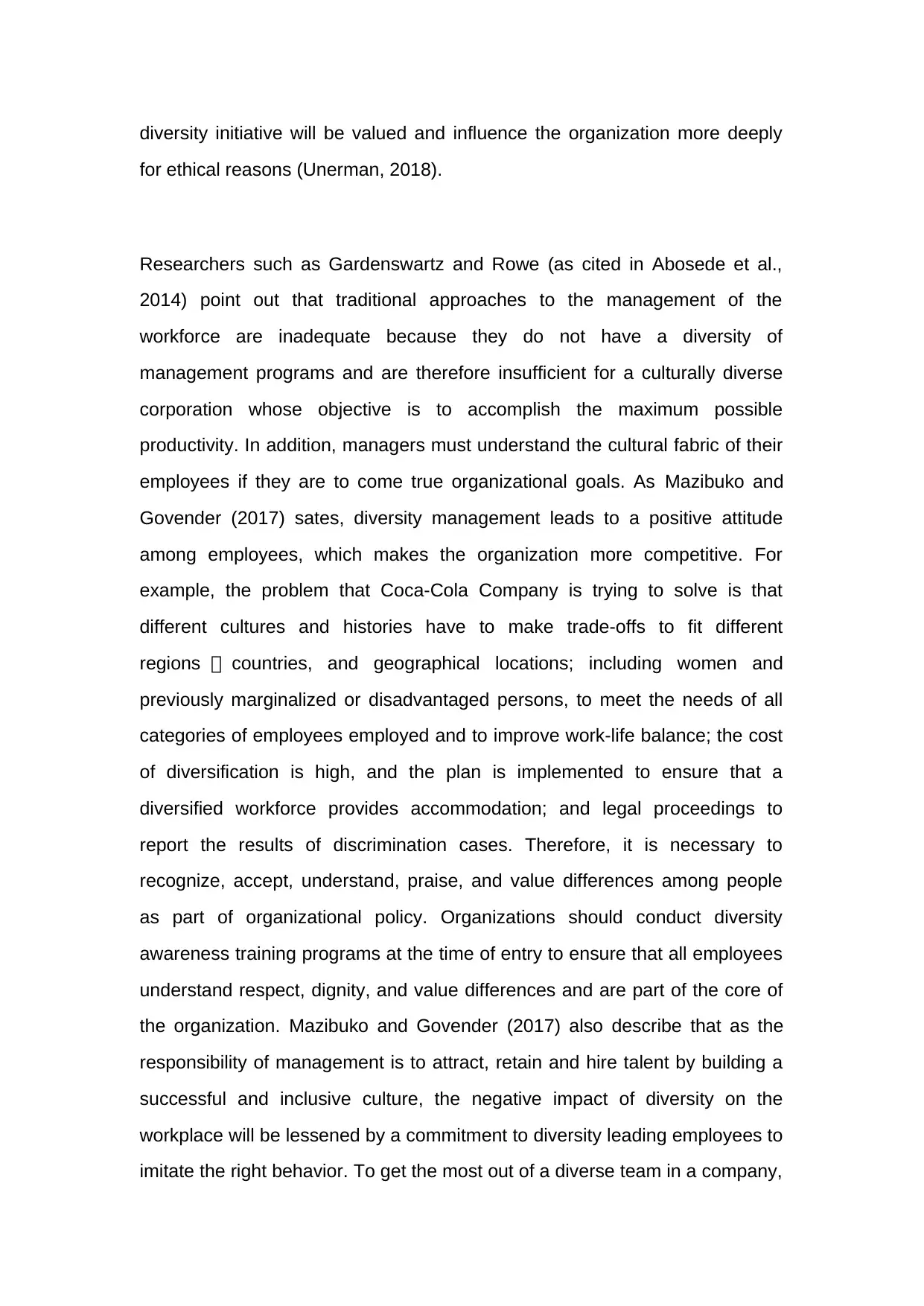
diversity initiative will be valued and influence the organization more deeply
for ethical reasons (Unerman, 2018).
Researchers such as Gardenswartz and Rowe (as cited in Abosede et al.,
2014) point out that traditional approaches to the management of the
workforce are inadequate because they do not have a diversity of
management programs and are therefore insufficient for a culturally diverse
corporation whose objective is to accomplish the maximum possible
productivity. In addition, managers must understand the cultural fabric of their
employees if they are to come true organizational goals. As Mazibuko and
Govender (2017) sates, diversity management leads to a positive attitude
among employees, which makes the organization more competitive. For
example, the problem that Coca-Cola Company is trying to solve is that
different cultures and histories have to make trade-offs to fit different
regions , countries, and geographical locations; including women and
previously marginalized or disadvantaged persons, to meet the needs of all
categories of employees employed and to improve work-life balance; the cost
of diversification is high, and the plan is implemented to ensure that a
diversified workforce provides accommodation; and legal proceedings to
report the results of discrimination cases. Therefore, it is necessary to
recognize, accept, understand, praise, and value differences among people
as part of organizational policy. Organizations should conduct diversity
awareness training programs at the time of entry to ensure that all employees
understand respect, dignity, and value differences and are part of the core of
the organization. Mazibuko and Govender (2017) also describe that as the
responsibility of management is to attract, retain and hire talent by building a
successful and inclusive culture, the negative impact of diversity on the
workplace will be lessened by a commitment to diversity leading employees to
imitate the right behavior. To get the most out of a diverse team in a company,
for ethical reasons (Unerman, 2018).
Researchers such as Gardenswartz and Rowe (as cited in Abosede et al.,
2014) point out that traditional approaches to the management of the
workforce are inadequate because they do not have a diversity of
management programs and are therefore insufficient for a culturally diverse
corporation whose objective is to accomplish the maximum possible
productivity. In addition, managers must understand the cultural fabric of their
employees if they are to come true organizational goals. As Mazibuko and
Govender (2017) sates, diversity management leads to a positive attitude
among employees, which makes the organization more competitive. For
example, the problem that Coca-Cola Company is trying to solve is that
different cultures and histories have to make trade-offs to fit different
regions , countries, and geographical locations; including women and
previously marginalized or disadvantaged persons, to meet the needs of all
categories of employees employed and to improve work-life balance; the cost
of diversification is high, and the plan is implemented to ensure that a
diversified workforce provides accommodation; and legal proceedings to
report the results of discrimination cases. Therefore, it is necessary to
recognize, accept, understand, praise, and value differences among people
as part of organizational policy. Organizations should conduct diversity
awareness training programs at the time of entry to ensure that all employees
understand respect, dignity, and value differences and are part of the core of
the organization. Mazibuko and Govender (2017) also describe that as the
responsibility of management is to attract, retain and hire talent by building a
successful and inclusive culture, the negative impact of diversity on the
workplace will be lessened by a commitment to diversity leading employees to
imitate the right behavior. To get the most out of a diverse team in a company,
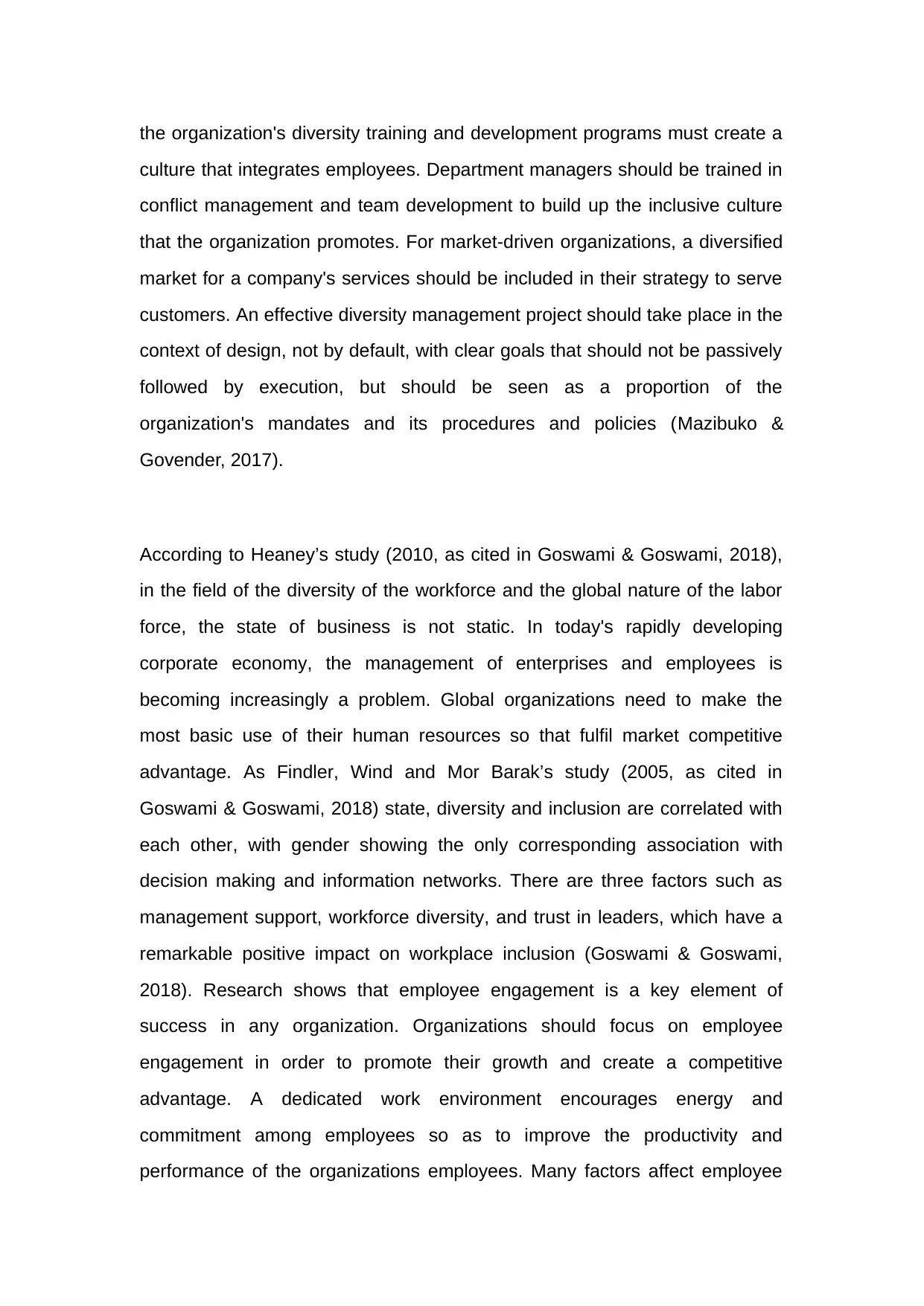
the organization's diversity training and development programs must create a
culture that integrates employees. Department managers should be trained in
conflict management and team development to build up the inclusive culture
that the organization promotes. For market-driven organizations, a diversified
market for a company's services should be included in their strategy to serve
customers. An effective diversity management project should take place in the
context of design, not by default, with clear goals that should not be passively
followed by execution, but should be seen as a proportion of the
organization's mandates and its procedures and policies (Mazibuko &
Govender, 2017).
According to Heaney’s study (2010, as cited in Goswami & Goswami, 2018),
in the field of the diversity of the workforce and the global nature of the labor
force, the state of business is not static. In today's rapidly developing
corporate economy, the management of enterprises and employees is
becoming increasingly a problem. Global organizations need to make the
most basic use of their human resources so that fulfil market competitive
advantage. As Findler, Wind and Mor Barak’s study (2005, as cited in
Goswami & Goswami, 2018) state, diversity and inclusion are correlated with
each other, with gender showing the only corresponding association with
decision making and information networks. There are three factors such as
management support, workforce diversity, and trust in leaders, which have a
remarkable positive impact on workplace inclusion (Goswami & Goswami,
2018). Research shows that employee engagement is a key element of
success in any organization. Organizations should focus on employee
engagement in order to promote their growth and create a competitive
advantage. A dedicated work environment encourages energy and
commitment among employees so as to improve the productivity and
performance of the organizations employees. Many factors affect employee
culture that integrates employees. Department managers should be trained in
conflict management and team development to build up the inclusive culture
that the organization promotes. For market-driven organizations, a diversified
market for a company's services should be included in their strategy to serve
customers. An effective diversity management project should take place in the
context of design, not by default, with clear goals that should not be passively
followed by execution, but should be seen as a proportion of the
organization's mandates and its procedures and policies (Mazibuko &
Govender, 2017).
According to Heaney’s study (2010, as cited in Goswami & Goswami, 2018),
in the field of the diversity of the workforce and the global nature of the labor
force, the state of business is not static. In today's rapidly developing
corporate economy, the management of enterprises and employees is
becoming increasingly a problem. Global organizations need to make the
most basic use of their human resources so that fulfil market competitive
advantage. As Findler, Wind and Mor Barak’s study (2005, as cited in
Goswami & Goswami, 2018) state, diversity and inclusion are correlated with
each other, with gender showing the only corresponding association with
decision making and information networks. There are three factors such as
management support, workforce diversity, and trust in leaders, which have a
remarkable positive impact on workplace inclusion (Goswami & Goswami,
2018). Research shows that employee engagement is a key element of
success in any organization. Organizations should focus on employee
engagement in order to promote their growth and create a competitive
advantage. A dedicated work environment encourages energy and
commitment among employees so as to improve the productivity and
performance of the organizations employees. Many factors affect employee
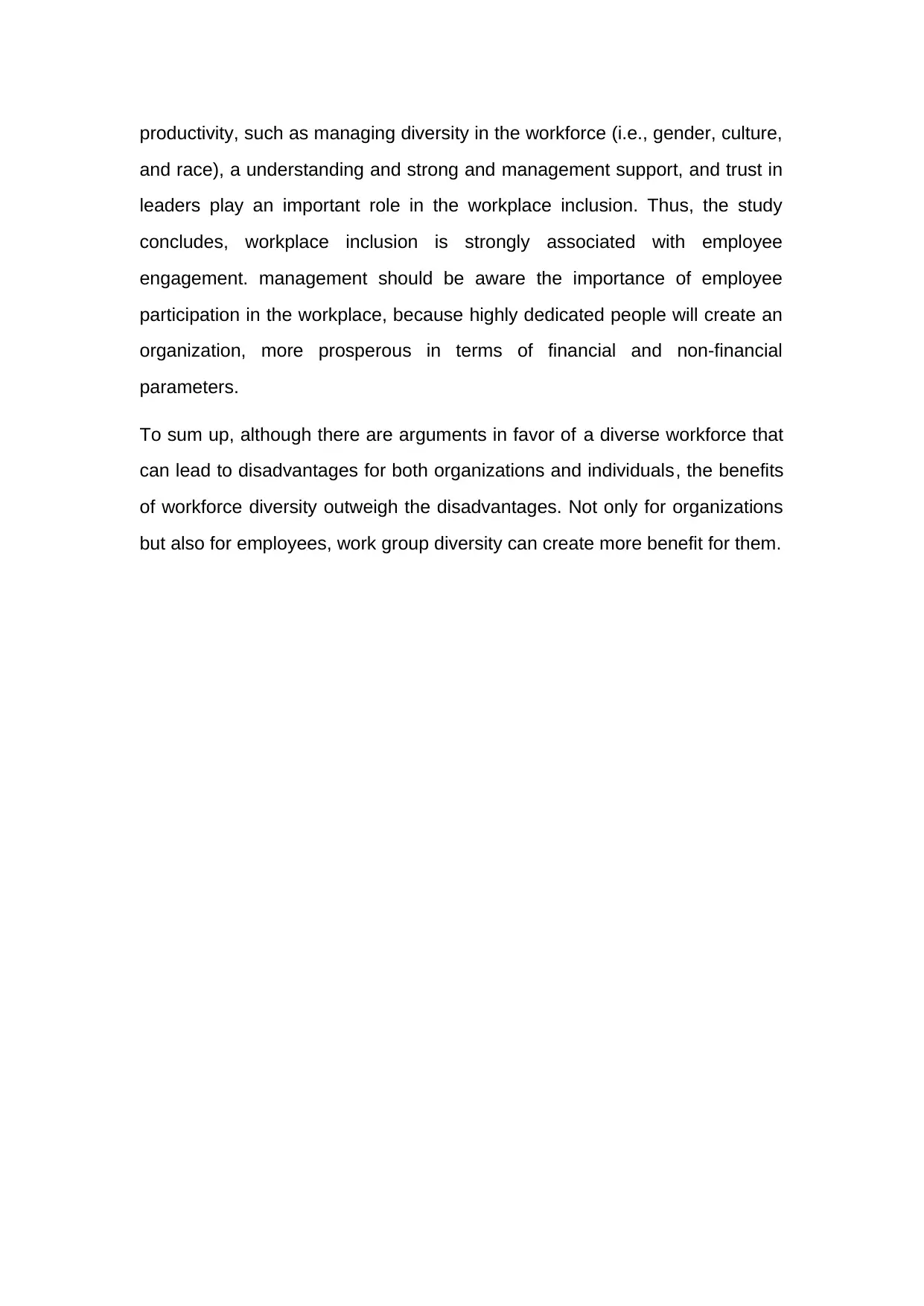
productivity, such as managing diversity in the workforce (i.e., gender, culture,
and race), a understanding and strong and management support, and trust in
leaders play an important role in the workplace inclusion. Thus, the study
concludes, workplace inclusion is strongly associated with employee
engagement. management should be aware the importance of employee
participation in the workplace, because highly dedicated people will create an
organization, more prosperous in terms of financial and non-financial
parameters.
To sum up, although there are arguments in favor of a diverse workforce that
can lead to disadvantages for both organizations and individuals, the benefits
of workforce diversity outweigh the disadvantages. Not only for organizations
but also for employees, work group diversity can create more benefit for them.
and race), a understanding and strong and management support, and trust in
leaders play an important role in the workplace inclusion. Thus, the study
concludes, workplace inclusion is strongly associated with employee
engagement. management should be aware the importance of employee
participation in the workplace, because highly dedicated people will create an
organization, more prosperous in terms of financial and non-financial
parameters.
To sum up, although there are arguments in favor of a diverse workforce that
can lead to disadvantages for both organizations and individuals, the benefits
of workforce diversity outweigh the disadvantages. Not only for organizations
but also for employees, work group diversity can create more benefit for them.
1 out of 7
Related Documents
Your All-in-One AI-Powered Toolkit for Academic Success.
+13062052269
info@desklib.com
Available 24*7 on WhatsApp / Email
![[object Object]](/_next/static/media/star-bottom.7253800d.svg)
Unlock your academic potential
© 2024 | Zucol Services PVT LTD | All rights reserved.





